PRESERVATION OF 19TH-CENTURY NEGATIVES IN THE NATIONAL ARCHIVES
CONSTANCE McCABE
4 IDENTIFICATION OF COLLODION NEGATIVES
TO PROVIDE appropriate care it is of fundamental importance to recognize the process by which a glass plate negative was made. Collodion negatives have occasionally been misidentified as gelatin dry plates. While the fundamental approach to preservation of glass negatives is the same for collodion or gelatin negatives, conservation treatment approaches differ significantly depending on the nature and extent of deterioration. Factors to consider (and not to consider) when attempting to differentiate collodion from gelatin glass plate negatives include image color, image appearance, surface character, and plate thickness.
4.1 PLATE THICKNESS
All very large collodion plates and many smaller collodion negatives were made on relatively thick glass (5/32–3/16 in) because it does not break as easily as thin glass. Most plates are approximately ⅛ in thick; rarely do they exceed � in. A few small negatives in the holdings of the National Archives are only 1/16 in thick, and most are approximately the same thickness as gelatin plates of comparable size (Witkin and London 1979, 34). Glass thickness, therefore, cannot be considered an important factor in isolating collodion from gelatin negatives.
4.2 IMAGE COLOR
The appearance of a negative will differ according to the combination of chemical processing steps employed in its creation. For example, when viewed in reflected light, a collodion negative developed with iron sulfate and fixed with potassium cyanide will appear lighter in color than one developed with pyrogallic acid and fixed with a thiosulfate fixer (“hypo”), which appears black (Towler 1879, 121; Archer 1854, 36, 39). Other steps in the processing of collodion negatives often included intensification and occasionally reduction, which also affected the final image color (Towler 1879, 124; Lea 1871, 169, 171–77; Lavedrine and Garnier 1989). These differences in processing have caused confusion among photographic historians. Collodion negatives have been described as appearing “creamy or milky in color” (Coe and Howarth-Booth 1983, 13)2, “light tan or gray” (Weinstein and Booth 1977, 715), “dull tan” (Gill 1978), “typically brownish yellow and highly reflective” (Eastman Kodak Co. 1979, 57), and “brown-black in the shadows and cream in the highlights” (Rempel 1979) in reflected light. These descriptions of collodion negatives are only partially accurate. Approximately 40% of the collodion negatives in the holdings of the National Archives are quite black and neutral in hue. It is possible that custodians of collodion negatives have mistaken black-colored collodion negatives for gelatin dry plates of original collodion negatives for duplicate negatives. Collodion negatives may appear in the colors described above as well as olive green, brick red, and lemon yellow or combinations of several colors on one plate.
Caretakers of photographic negatives must remember that gelatin negatives may also be found in a variety of image colors. In fact, gelatin negatives are occasionally found that resemble ambrotypes (fig. 1). While the color of a plate is an important factor in identifying the process by which glass negatives were made, the color of a plate alone must not be considered the determining factor. Accurate dating, image appearance, and surface character are also crucial for identification of the negative process.
Fig. 1.
Two negatives that resemble ambrotypes , both seen in reflected light on a dark background. Above: A three-image collodion plate of Abraham Lincoin by the Matthew Brady Studio (RG 111-B-3658-C). Below: A gelatin dry plate portrait with a light-hued image (RG 19N-46-21-21).
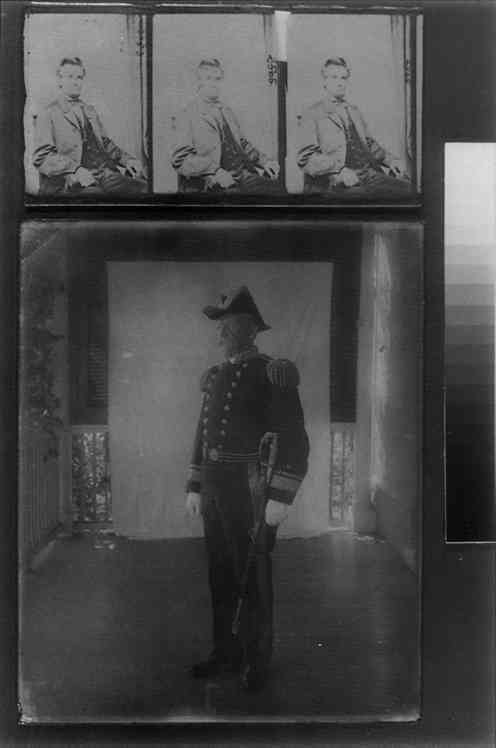 |
4.3 IMAGE APPEARANCE AND SURFACE CHARACTER
To isolate black-colored collodion negatives from gelatin dry plates, the plate edges and corners where there is image density (dark areas) should be examined. A gelatin plate will generally have a very straight, regular, and even surface along the edge due to its production by machine. Evenly fogged image silver along the edge may also be a clue that the plate was coated by machine, especially if the fogging is not related to the photographic image (fig. 2). The evennes of coating is a relative matter, and while gelatin plates are nearly always coated evenly, gelatin along the edges may lift during handling or processing (fig. 3) or as a result of deterioration. The image along the edges of a collodion plate will only rarely be uniform, indicating that the image-bearing layer was coated by hand (figs. 4–5). Other physical characteristics, such as fingerprints in the image at corners or at edges, provide additional evidence that the plate was coated by hand (figs. 6–7).
Fig. 2.
The corner of a gelation dry plate generally has a smooth and even surface along the edge, indicating an emulsion coated by a machine. The even fogging of image silver along the edge of the binder indicates regularity in binder coating (RG 57-PS-46).
 |
Fig. 3.
Another gelatin dry plate shows primarily even edges. Slight irregularities are ofter found, due in part to handling during chemical processing (RG 19N-46-21-19).
 |
Fig. 4.
The corner of a collodion negative exhibits various types of unevenness, such as this irregularly hand-coated plate (RG 77-KW-21).
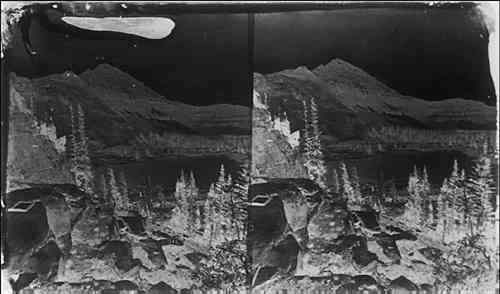 |
Fig. 5.
In this detail of what should be an even-toned sky area, the irregular collodion application is evident (RG 106-WB-88).
 |
Fig. 6.
Collodion plates usually exhibit at least one corner with a fingerprint (RG 111-B-280).
 |
Fig. 7.
Another collodion plate with a finger print in one corner (RG 57-PS-559).
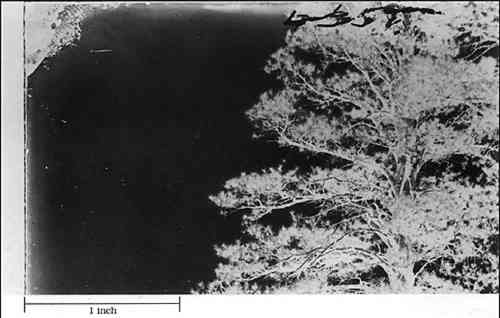 |
A common misconception regarding the appearance of collodion negatives involves their surface character. Confusing the thin, smooth, and virtually two-dimensional collodion layer with the relatively thick and often uneven varnish coating, authors have given descriptions such as, “The emulsion coating layer is often uneven and in raking light shows swirls, thick or thin areas” (Witkin and London 1979, 34).3 Another description states, “Since the collodion is flowed on by hand, it often shows tidal marks and varying thickness” (Eastman Kodak Co. 1985).4
The uneven “swirls, thick or thin areas” described above actually describe not the collodion binder layer but the varnish layer that coats the binder. When viewed by the naked eye in raking light, an unvarnished negative will appear smooth and matte surfaced. The unvarnished collodion binder layer is quite thin and, except along the plate edges, two-dimensional in appearance. Some collodion plates do exhibit varying degrees of density due to uneven coating. This type of image irregularly is often seen in large, even-toned areas, such as the sky in landscape views (figs. 4–5, 9–10). These unevenly coated plates, however, do not show associated three-dimensional ridges (figs. 4–5, 8–10).
Fig. 8.
Striations in what should be an even-toned sky area seen in a collodion plate (RG 106-WB-272).
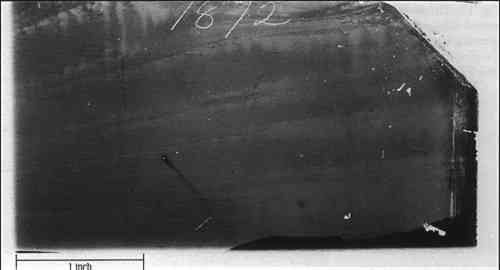 |
Fig. 9.
Image irregularity in the sky area due to uneven coating by hand (RG 57-PS-464).
 |
Fig. 10.
A print from the same collodion negative as shown in figure 9 (RG 57-PS-464).
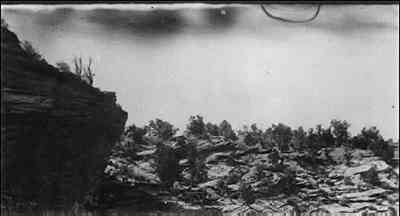 |
A varnished glass negative will usually show uneven surface characteristics not visible on an unvarnished plate. This three-dimensional surface appearance is due primarily to the relatively thick varnished layer and should not be confused with the binder layer beneath. These three-dimensional ridges, or “flow marks,” of the varnish on the surface of the plate can be present on gelatin as well as collodion negatives (figs. 11–15). The varnish surface is usually rather glossy, but it may be matte. Although virtually all collodion negatives were varnished for protection from abrasion, the varnish layer may be quite thin and difficult to see with the unaided eye. Since the surfaces of some collodion and gelatin negatives may look similar, they are difficult to distinguish by surface characteristics alone. Occasionally an unvarnished or a partially varnished collodion negative will be found. Unvarnished collodion negative surfaces (whether image silver is present or not) will normally appear quite thin, smooth, and abraded when compared with varnished collodion plate surfaces (figs. 16–23).
Fig. 11.
Three-dimensional ridges of the varnish layer seen on a collodion plate (RG 57-PS-54).
 |
Fig. 12.
Another example of three-dimensional varnish “flow marks” seen on a collodion negative (RG 57-PS-536)
 |
Fig. 13.
Three-dimensional ridges seen on a varnished gelatin dry plate negative (RG 57-PS-120)
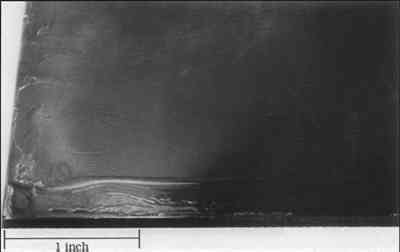 |
Fig. 14.
Another gelatin dry plate negative illustrating three-dimension al ridges (RG 19N-46-21-19)
 |
Fig. 15.
An unvarnished gelatin dry plate (RG 57-PS-33)
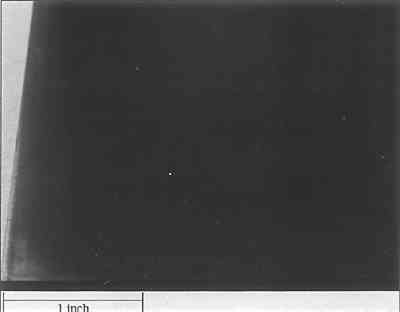 |
Fig. 16.
A collodian negative with only the left portion varnished, seen in transmitted light. Note the severe abrasion on the side not protected by varnish (RG 111-B-4998).
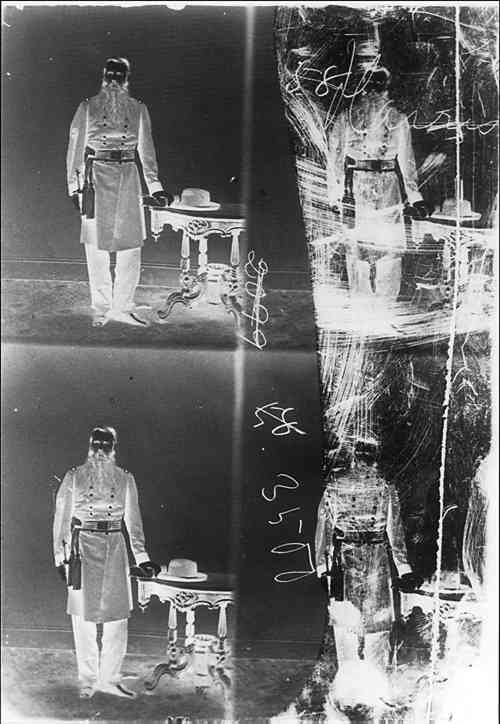 |
Fig. 17.
A detail of the same collodion negative shown in figure 16. seen in reflected light on a light colored background.
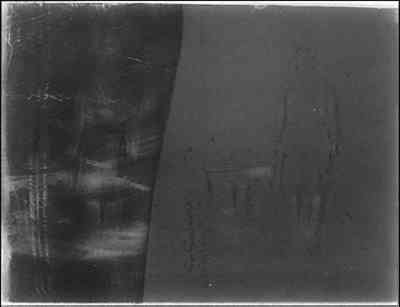 |
Fig. 18.
A print from the same detail of the collodion negative shown in figures 16–17
 |
Fig. 19.
Seen at an oblique angle, the same partially varnished collodion negative shown in figures 16–18
 |
Fig. 20.
A varnished gelatin dry plate negative seen in transmitted light. Note that the top corners are not varnished (RG 19N-48-21-21).
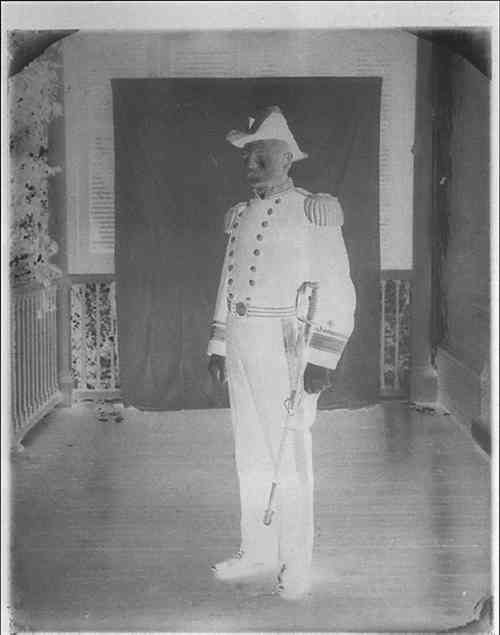 |
Fig. 21.
A detail of the same gelatin negative shown in figure 20, reflected light on a light-colored background.
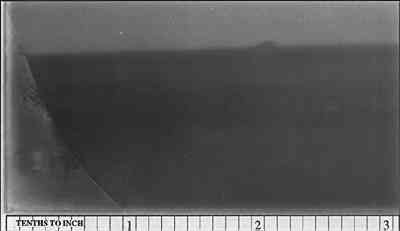 |
Fig. 22.
A print from the same detail of the gelatin negative shown in figure 20–21. Note the lack of abrasion in the unvarnished area.
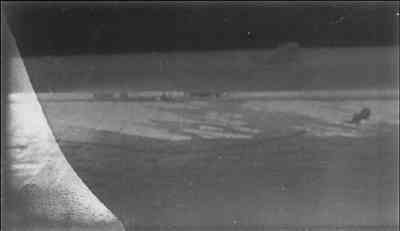 |
Fig. 23.
Seen at an oblique angle, the same partially varnished gelatin negative shown in figures 20–22.
 |
The difference between collodion and gelatin negatives on glass can often be quite subtle; it takes experience and practice to become proficient in identifying collodion negatives. Various chemical processes were employed to create these negatives, and deterioration may have taken place over time. The effects of these and unknown factors give the negatives image appearances that may be difficult or impossible to explain. To generalize about the appearance of collodion and gelatin glass plate negatives is not possible, as both can have similar characteristics that may make differentiation confusing. It should be noted that unless deterioration is evident, preservation of both negative types requires similar approaches.
|






















